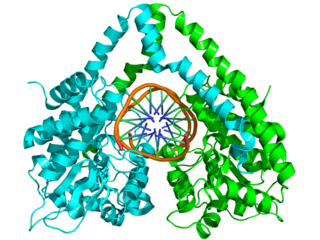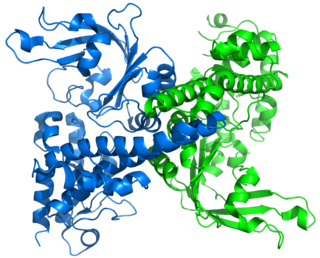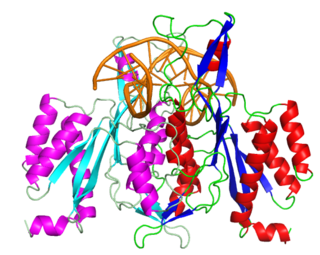| Enzyme | PDB code | Source | Recognition sequence | Cut | Isoschizomers |
| BdiI | | Brevibacterium divaricatum | 5' ATCGAT
3' TAGCTA | 5' ---AT CGAT--- 3'
3' ---TAGC TA--- 5' | BavCI, Bci29I, Bli41I, Bli86I, BseCI, BsuTUI, Rme21I, SpmI |
| BdiSI | | Bacteroides distasonis | 5' CTRYAG
3' GAYRTC | 5' ---C TRYAG--- 3'
3' ---GAYRT C--- 5' | |
| BecAII | | Brevibacterium sp. A | 5' GGCC
3' CCGG | 5' ---GG CC--- 3'
3' ---CC GG--- 5' | |
| BepI | | Brevibacterium epidermidis | 5' CGCG
3' GCGC | 5' ---CG CG--- 3'
3' ---GC GC--- 5' | AccII, BepI, BspFNI, BstUI, Bsu1532I, BtkI, FalII, FauBII, ThaI |
| BetI | | Brevibacterium acetyliticum | 5' WCCGGW
3' WGGCCW | 5' ---W CCGGW--- 3'
3' ---WGGCC W--- 5' | |
| BfaI [7] | | Bacteroides fragilis | 5' CTAG
3' GATC | 5' ---C TAG--- 3'
3' ---GAT C--- 5' | |
| BfiI | 2C1L | Bacillus firmus S8120 | 5' ACTGGG
3' TGACCC | 5' ---ACTGGGNNNNN --- 3'
3' ---TGACCCNNNN N--- 5' | BmrI |
| Bfi57I | | Butyrivibrio fibrisolvens OB157 | 5' GATC
3' CTAG | 5' --- GATC--- 3'
3' ---CTAG --- 5' | Bsp105I, Bsp143I, BspJI, BstMBI, CviAI, Kzo9I, NdeII, SsiBI |
| Bfi89I | | Butyrivibrio fibrisolvens OB189 | 5' YGGCCR
3' RCCGGY | 5' ---Y GGCCR--- 3'
3' ---RCCGG Y--- 5' | |
| BflI | | Bacillus flavothermus | 5' CCN7GG
3' GGN7CC | 5' ---CCNNNNN NNGG--- 3'
3' ---GGNN NNNNNCC--- 5' | |
| BfmI | | Bacillus firmus S8-336 | 5' CTRYAG
3' GAYRTC | 5' ---C TRYAG--- 3'
3' ---GAYRT C--- 5' | |
| BfrI | | Bacteroides fragilis | 5' CTTAAG
3' GAATTC | 5' ---C TTAAG--- 3'
3' ---GAATT C--- 5' | |
| BfrBI [8] | | Bacteroides fragilis BE3 | 5' ATGCAT
3' TACGTA | 5' ---ATGCA T--- 3'
3' ---T ACGTA--- 5' | Csp68KIII, EcoT22I, Mph1103I, PinBI, Ppu10I, SepI, SspD5II, Zsp2I |
| BfuI | | Bacillus firmus Auk 22-m21 | 5' GTATCC
3' CATAGG | 5' ---GTATCCN4NN --- 3'
3' ---CATAGGN4N N--- 5' | BciVI |
| BfuAI | | Bacillus fusiformis | 5' ACCTGC
3' TGGACG | 5' ---ACCTGCNNNN NNNN--- 3'
3' ---TGGACGNNNNNNNN --- 5' | Acc36I, BspMI, BveI |
| BfuCI | | Bacillus fusiformis 1226 | 5' GATC
3' CTAG | 5' --- GATC--- 3'
3' ---CTAG --- 5' | Bce243I, Bsp105I, BspFI, BstKTI, CpfI, HacI, MkrAI, Sth368I |
| BglI | 1DMU | Bacillus globigii | 5' GCCN5GGC
3' CGGN5CCG | 5' ---GCCNNNN NGGC--- 3'
3' ---CGGN NNNNCCG--- 5' | |
| BglII | 1ES8 | Bacillus globigii | 5' AGATCT
3' TCTAGA | 5' ---A GATCT--- 3'
3' ---TCTAG A--- 5' | |
| BimI | | Brevibacterium immotum | 5' TTCGAA
3' AAGCTT | 5' ---TT CGAA--- 3'
3' ---AAGC TT--- 5' | AcpI, AsuII, Bpu14I, BspT104I, CbiI, FspII, MlaI, PpaAI, SfuI |
| Bim19I | | Brevibacterium immotum 19 | 5' TTCGAA
3' AAGCTT | 5' ---TT CGAA--- 3'
3' ---AAGC TT--- 5' | AcpI, AsuII, Bpu14I, BspT104I, CbiI, FspII, MlaI, PpaAI, SfuI |
| Bim19II | | Brevibacterium immotum 19 | 5' GGCC
3' CCGG | 5' ---GG CC--- 3'
3' ---CC GG--- 5' | |
| BinI | | Bifidobacterium infantis 659 | 5' GGATC
3' CCTAG | 5' ---GGATCNNNN N--- 3'
3' ---CCTAGNNNNN --- 5' | | AclWI, AlwI, | BsrWI, | BspPI, |
|
| BlfI | | Bacillus licheniformis | 5' TCCGGA
3' AGGCCT | 5' ---T CCGGA--- 3'
3' ---AGGCC T--- 5' | AccIII, Aor13HI, BseAI, BsiMI, BspMII, Bsu23I, Kpn2I, PinBII |
| Bli41I | | Bacillus licheniformis 41 | 5' ATCGAT
3' TAGCTA | 5' ---AT CGAT--- 3'
3' ---TAGC TA--- 5' | Bci29I, Bli86I, BseCI, BsiXI, BsuTUI, Rme21I, SpmI, Ssp27144I |
| Bli86I | | Bacillus licheniformis 86 | 5' ATCGAT
3' TAGCTA | 5' ---AT CGAT--- 3'
3' ---TAGC TA--- 5' | BliAI, Bli41I, BseDI, BsiXI, Rme21I, SpmI, Ssp27144I, ZhoI |
| Bli736I | | Bacillus licheniformis 736 | 5' GGTCTC
3' CCAGAG | 5' ---GGTCTCN NNNN--- 3'
3' ---CCAGAGNNNNN --- 5' | |
| BliAI | | Bacillus licheniformis | 5' ATCGAT
3' TAGCTA | 5' ---AT CGAT--- 3'
3' ---TAGC TA--- 5' | BliRI, Bli41I, BsiXI, BspDI, Rme21I, SpmI, Ssp27144I, ZhoI |
| BliHKI | | Bacillus licheniformis HK | 5' CCTNAGG
3' GGANTCC | 5' ---CC TNAGG--- 3'
3' ---GGANT CC--- 5' | AocI, AxyI, Bse21I, Bsu36I, Eco81I, MstII, SauI, SshAI |
| BliRI | | Bacillus licheniformis | 5' ATCGAT
3' TAGCTA | 5' ---AT CGAT--- 3'
3' ---TAGC TA--- 5' | BciBI, BdiI, Bli41I, BsiXI, BspDI, BspXI, LplI, SpmI, ZhoI |
| BlnI | | Brevibacterium linens | 5' CCTAGG
3' GGATCC | 5' ---C CTAGG--- 3'
3' ---GGATC C--- 5' | AspA2I, AvrII, AvrBII, BspA2I, XmaJI |
| BloHI | | Bifidobacterium longum E194b | 5' RGATCY
3' YCTAGR | 5' ---R GATCY--- 3'
3' ---YCTAG R--- 5' | |
| BloHII | | Bifidobacterium longum E194b | 5' CTGCAG
3' GACGTC | 5' ---CTGCA G--- 3'
3' ---G ACGTC--- 5' | AjoI, Asp713I, BsuBI, CflI, CfuII, HalII, PstI, SalPI, SflI, Sst12I |
| BlpI | | Bacillus lentus | 5' GCTNAGC
3' CGANTCG | 5' ---GC TNAGC--- 3'
3' ---CGANT CG--- 5' | |
| BluI | | Brevibacterium luteum | 5' CTCGAG
3' GAGCTC | 5' ---C TCGAG--- 3'
3' ---GAGCT C--- 5' | AbrI, BssHI, BstVI, PanI, Sau3239I, Sfr274I, TliI, XhoI |
| Bme12I | | Bacillus megaterium 12 | 5' GATC
3' CTAG | 5' --- GATC--- 3'
3' ---CTAG --- 5' | Bfi57I, Bsp143I, BspJI, BstMBI, CviAI, Kzo9I, NlaII, SsiBI |
| Bme18I | | Bacillus megaterium 18 | 5' GGWCC
3' CCWGG | 5' ---G GWCC--- 3'
3' ---CCWG G--- 5' | BamNxI, BcuAI, Csp68KI, EagMI, FssI, HgiCII, HgiJI, SinI |
| Bme142I | | Bacillus megaterium 142 | 5' RGCGCY
3' YCGCGR | 5' ---RGC GCY--- 3'
3' ---YCG CGR--- 5' | | AccB2I, | BfoI, | Bsp143II, | | BstH2I, HaeII, LpnI |
|
| Bme216I | | Bacillus megaterium 216 | 5' GGWCC
3' CCWGG | 5' ---G GWCC--- 3'
3' ---CCWG G--- 5' | BamNxI, BcuAI, Csp68KI, Eco47I, FssI, HgiCII, HgiJI, SinI |
| Bme361I | | Bacillus megaterium 361 | 5' GGCC
3' CCGG | 5' ---GG CC--- 3'
3' ---CC GG--- 5' | |
| Bme585I | | Bacillus mesentericus 585 | 5' CCCGC
3' GGGCG | 5' ---CCCGCNNNN NN--- 3'
3' ---GGGCGNNNNNN --- 5' | |
| Bme1390I | | Bacillus megaterium RFL1390 | 5' CCNGG
3' GGNCC | 5' ---CC NGG--- 3'
3' ---GGN CC--- 5' | |
| Bme1580I | | Bacillus megaterium 1580 | 5' GKGCMC
3' CMCGKG | 5' ---GKGCM C--- 3'
3' ---C MCGKG--- 5' | |
| BmgBI | | Bacillus megaterium | 5' CACGTC
3' GTGCAG | 5' ---CAC GTC--- 3'
3' ---GTG CAG--- 5' | |
| BmrI [9] [10] | | Bacillus megaterium | 5' ACTGGG
3' TGACCC | 5' ---ACTGGGNNNNN --- 3'
3' ---TGACCCNNNN N--- 5' | BfiI |
| BmtI | | Bacillus megaterium S2 | 5' GCTAGC
3' CGATCG | 5' ---GCTAG C--- 3'
3' ---C GATCG--- 5' | | AceII, AsuNHI, | BspOI, | NheI, | | LlaG2I, PstNHI |
|
| BmyI [11] | | Bacillus mycoides | 5' GDGCHC
3' CHCGDG | 5' ---GDGCH C--- 3'
3' ---C HCGDG--- 5' | AocII, BsoCI, Bsp1286I, BspLS2I, MhlI, NspII, SduI |
| BnaI | | Bacillus natto B3364 | 5' GGATCC
3' CCTAGG | 5' ---G GATCC--- 3'
3' ---CCTAG G--- 5' | AccEBI, BamHI, Bce751I, BstI, CelI, OkrAI, Nsp29132II, Pfl8I, SolI |
| BoxI | | Brevibacterium oxydans Iti 12-025 | 5' GACN4GTC
3' CTGN4CAG | 5' ---GACNN NNGTC--- 3'
3' ---CTGNN NNCAG--- 5' | |
| BpcI | | Bacillus sphaericus | 5' CTRYAG
3' GAYRTC | 5' ---C TRYAG--- 3'
3' ---GAYRT C--- 5' | |
| BpiI | | Bacillus pumilus sw 4-3 | 5' GAAGAC
3' CTTCTG | 5' ---GAAGACNN NNNN--- 3'
3' ---CTTCTGNNNNNN --- 5' | |
| BplI | | Bacillus pumilus | 5' GAGN5CTC
3' CTCN5GAG | 5' ---GAGN5CTCN7NNNNNN --- 3'
3' ---CTCN5GAGN7N NNNNN--- 5' | |
| BpmI | | Bacillus pumilus | 5' CTGGAG
3' GACCTC | 5' ---CTGGAGN13NNN --- 3'
3' ---GACCTCN13N NN--- 5' | |
| BpoAI | | Bacillus polymyxa | 5' ATTAAT
3' TAATTA | 5' ---AT TAAT--- 3'
3' ---TAAT TA--- 5' | AseI, AsnI, PshBI, Sru4DI, VspI |
| BptI | | Bacillus pantothenticus | 5' CCWGG
3' GGWCC | 5' ---CC WGG--- 3'
3' ---GGW CC--- 5' | AjnI, BseBI, Bse16I, BstNI, BstOI, BstM6I, Bst2UI, EcoRII, MvaI |
| BpuI | | Bacillus pumilus AHU1387A | 5' GRGCYC
3' CYCGRG | 5' ---GRGCY C--- 3'
3' ---C YCGRG--- 5' | |
| Bpu10I | | Bacillus pumilus 10 | 5' CCTNAGC
3' GGANTCG | 5' ---CC TNAGC--- 3'
3' ---GGANT CG--- 5' | |
| Bpu14I | | Bacillus pumilus 14 | 5' TTCGAA
3' AAGCTT | 5' ---TT CGAA--- 3'
3' ---AAGC TT--- 5' | AcpI, AsuII, BsiCI, BspT104I, CbiI, FspII, MlaI, PpaAI, SfuI |
| Bpu95I | | Bacillus pumilus 95 | 5' CGCG
3' GCGC | 5' ---CG CG--- 3'
3' ---GC GC--- 5' | AccII, BepI, BspFNI, BstUI, Bsu1532I, FalII, FnuDII, MvnI, ThaI |
| Bpu1102I | | Bacillus pumilus RFL1102 | 5' GCTNAGC
3' CGANTCG | 5' ---GC TNAGC--- 3'
3' ---CGANT CG--- 5' | |
| BpuAI [12] | | Bacillus pumilus | 5' GAAGAC
3' CTTCTG | 5' ---GAAGACNN NNNN--- 3'
3' ---CTTCTGNNNNNN --- 5' | |
| BpuAmI | | Bacillus pumilus | 5' GAGCTC
3' CTCGAG | 5' ---GAG CTC--- 3'
3' ---CTC GAG--- 5' | |
| BpuB5I | | Bacillus pumilus | 5' CGTACG
3' GCATGC | 5' ---C GTACG--- 3'
3' ---GCATG C--- 5' | |
| BpuDI | | Bacillus pumilus 1117 | 5' CCTNAGC
3' GGANTCG | 5' ---CC TNAGC--- 3'
3' ---GGANT CG--- 5' | |
| BpuEI | | Bacillus pumilus 2187a | 5' CTTGAG
3' GAACTC | 5' ---CTTGAGN13NNN --- 3'
3' ---GAACTCN13N NN--- 5' | |
| BpuJI [13] [14] | 2VLA | Bacillus pumilus RFL1458 | 5' CCCGT
3' GGGCA | 5' ---CCCGTN10N NNNNNNNN--- 3'
3' ---GGGCAN10NNNNNNNNN --- 5' | — None in May 2010 — |
| BpuSI | | Bacillus pumilus | 5' GGGAC
3' CCCTG | 5' ---GGGACN9N NNNN--- 3'
3' ---CCCTGN9NNNNN --- 5' | |



